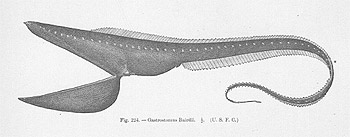 Surveying Voyages of Ships Adventure and Beagle
Surveying Voyages of Ships Adventure and Beagle The Physical Geography of the Sea
The Physical Geography of the Sea The Depths of the Sea
The Depths of the Sea The Voyage of the "Challenger."
The Voyage of the "Challenger." Deep-Sea Sounding And Dredging
Deep-Sea Sounding And Dredging Norwegian North-Atlantic Expedition
Norwegian North-Atlantic Expedition The Fisheries of the United States
The Fisheries of the United States Three Cruises of the "Blake"
Three Cruises of the "Blake" The Gulf Stream: Methods of Investigation
The Gulf Stream: Methods of Investigation Aus den Tiefen des Weltmeeres
Aus den Tiefen des Weltmeeres
Three Cruises of the United States Coast and Geodetic Survey Steamer "Blake": In the Gulf of Mexico, in the Caribbean Sea, and Along the Atlantic Coast of the United States, from 1877 to 1880
From 1877 to 1880, the U.S. Coast and Geodetic Survey dispatched the steamer Blake on three cruises of discovery—two expeditions to Florida, the Gulf of Mexico, and the Caribbean and one off the eastern Atlantic coast as far north as the Gulf of Maine. These cruises were designed to increase knowledge of the depths of the oceans and the animals and plants living on or near the bottom and to pioneer technological advances in oceanography.
This excerpt includes the title page, figures 29 and 173, and pages 171-184 from Volume I of the Three Cruises of the United States Coast and Geodetic Survey Steamer "Blake" .
You may need to download the Flash Player to view the book. To navigate through the book in Flash mode, click once on any page corner; click on any corner, hold, and drag the page; or use the menu at the bottom of the image. In the menu, the arrows will flip the book pages, the magnifying glass will allow you to zoom in on the page and scroll up and down the page, the printer icon will allow you to print the page in view, and the icon to the far right will allow you to view thumbnails of the included pages.
You can also view a non-Flash version.
Alexander Agassiz (ag'-uh-see), the author of Three Cruises, is often considered the premier American oceanographer of the 19th century. Son of the famed naturalist Louis Agassiz, Alexander also was an accomplished naturalist. At the time he accompanied the U.S. Coast and Geodetic Survey Steamer Blake on the three cruises chronicled in this work, Agassiz was the Director of Harvard's Museum of Comparative Zoology; later he became president of the National Academy of Sciences. Previously, Agassiz helped to organize and describe species collected by the famous British Challenger expedition between 1872 and 1876.

This figure illustrates the foraging technique of the deep-sea fish, Gastrostomus Bairdii. The huge mouth funnels water and the food it contains into a large pouch behind the head. Scientists aboard one of the Blake's voyages caught this specimen at a depth of 898 fathoms (5,388 feet). (v. II, fig. 224)
During the 1877-1880 cruises highlighted in this volume, the steamer Blake pioneered development of oceanographic equipment, collected hundreds of deep-sea and coral reef species, traveled thousands of miles, studied the Gulf Stream, collected ocean temperatures, conducted sounding operations to determine ocean depths, and examined submarine deposits. Invited by the superintendent of the U.S. Coast and Geodetic Survey to act as naturalist on board the Blake, Agassiz called on his prior experiences to improve copper mining in Michigan to advance oceanographic equipment used on the Blake.
This volume draws upon the same groundbreaking work on the Blake that revolutionized oceanographic research trumpeted in Deep-Sea Sounding and Dredging by Charles Sigsbee, also in this collection of rare 19th century oceanographic books. Volume I of Three Cruises contains details of the equipment used on the voyages and improvements made to it, narrative essays of the cruises, sketches of the history of Gulf Stream studies and deep-sea exploration, and, for Agassiz, the first of many studies of Florida's coral reefs. A map of the Blake's cruises is at the end of this volume. Volume II contains descriptions and images of many of the species collected during the cruises.
- Author: Alexander Agassiz (1835-1910)
- Date Published: 1888
- Publisher: Houghton, Mifflin and Company, The Riverside Press
- Location: Boston and New York, Cambridge
- Length:
- Volume I, 314 pages
- Volume II, 220 pages
View Complete Rare Book
Three Cruises of the United States Coast and Geodetic Survey Steamer "Blake": In the Gulf of Mexico, in the Caribbean Sea, and Along the Atlantic Coast of the United States, from 1877 to 1880
Volume
I (pdf, 165 MB)
Volume
II (pdf, 98 MB)
